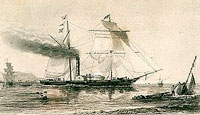
The Honourable East India Company ship Nemesis
In 1840, when she arrived off their coast, the Chinese called the Honourable East India Company ship Nemesis, the devil ship. She was the first British ocean-going iron warship. In addition to two masts, she was powered by two two sixty horsepower Forrester steam engines driving paddle wheels. She was armed with two pivot-mounted 32 pounder and four 6 pounder guns, and a rocket launcher. Though underpowered and under-gunned she proved to be extremely effective in the coastal battles of the Opium Wars. The Chinese had nothing that could remotely match her.
In a recent article in the Huffington Post, Rory Fitzgerald wonders whether the ghost of the Nemesis is still driving Chinese military and foreign policy.
China’s U.S. Visit: The Chinese Are Haunted by a Ghost Ship
In the Second Battle of Chuenpee in 1841, the Nemesis and a fleet of other British ships captured a strategically vital Chinese fort and the Nemesis then swiftly attacked a fleet of 15 junks under Admiral Kuan T’ien-p’ei in Anson’s Bay. The ship fired a rocket that struck a junk just near the shocked Chinese admiral.
A British officer gave this account of the incident:
“The very first rocket fired from the Nemesis was seen to enter the large junk… and almost the instant afterwards it blew up with a terrific explosion, launching into eternity every soul on board, and pouring forth its blaze like the mighty rush of fire from a volcano.
“The instantaneous destruction of the huge body seemed appalling to both sides engaged. The smoke, and flame, and thunder of the explosion, with the broken fragments falling round, and even portions of dissevered bodies scattering as they fell, were enough to strike with awe, if not fear, the stoutest heart that looked upon it.”
The battle had been joined at 8 am, and by 11.30 the Chinese junks had surrendered. No British were killed, but between 500-600 Chinese died. The Island of Hong Kong became a British possession, and was to remain so until the 1990s.
The resonance of this humiliating historical lesson is perhaps why the Chinese today spend a perplexing amount of time and energy investing in the very highest technology military equipment available, like the Chengdu J-20 stealth aircraft. Its test flight was “leaked” just before the Chinese president’s US visit.

It would not be surprising if this was true, although I’m not informed enough about Chinese history or current politics to be sure.
For almost the first half of the 19th century, US naval policy was dominated by fear of naval blockade, including construction of ships specifically intended to break a blockade. this was a reaction (maybe over-reaction?) to the War of 1812 when the British Navy brought US sea trade to a standstill and blockaded most of our Navy in harbor. A bad war experience can have more, and longer lasting, influence on future policy than a good one.
What I find so interesting about the Nemesis is that she was designed, built and operated by a more or less private company and not a navy, which might explain the adoption of relatively advanced technology for its day.
And yes, it is remarkable how events in history can shape policies long into the future.
Does anyone know what happened to this warship? I know she saw action in the Philippines and Indonesia, but what was her ultimate fate?
Please see my new book ” Nemesis, the first iron warship and her world”. She ended in Calcutta in 1855.